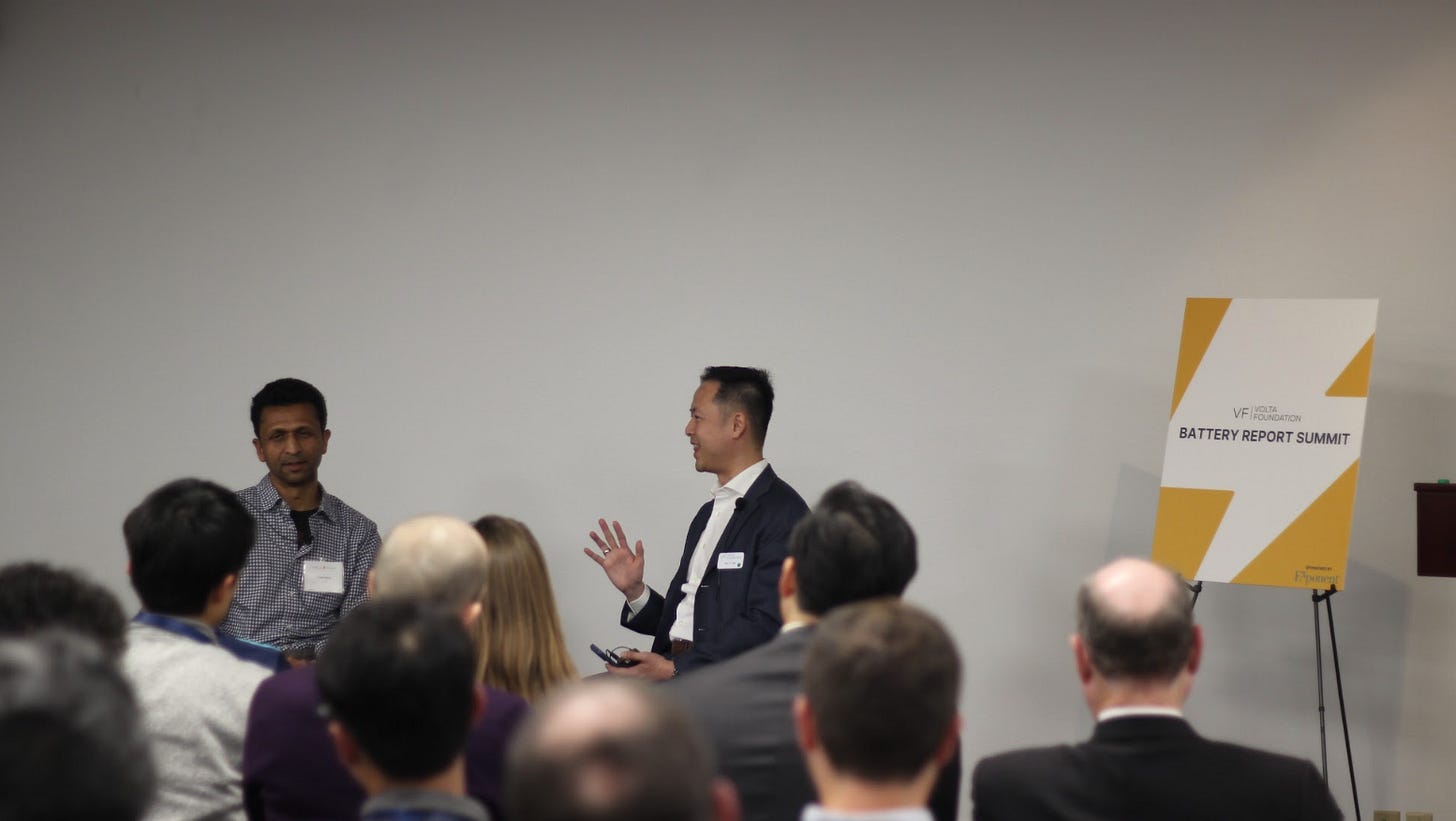Volta's annual battery report launch!
A recap of the Volta Foundation launch event at Exponent's office
I got to stop by the Volta Foundation annual report launch at the Exponent office. I was glad to be in the room with the Volta Foundation team and listen to these great conversations… thank you to Exponent for hosting! For those who couldn’t come, here are my key takeaways.
- Nick
Highlighting notes and takeaways. There were 4 main sections:
Opening keynote from Dr Keith Beers (Principal Engineer, Exponent)
2025 Battery Report recap from Volta Foundation’s Linda Jing, Maithri Venkat, Charlie Parker, and Nika Ptushkina
Fireside chat with Vineet Mehta (Director of Battery and Powertrain Architecture, Tesla) and Yen Yeh (Executive Director, Volta Foundation)
“State of the industry” panel with Logan Goldie-Scott (Head of Research, Generate Capital), Nathan Niese (Managing Director and Partner, BCG), Dr Adam Cohn (Senior Managing Scientist, Exponent), hosted by Michael Liu (Managing Director, Volta Foundation)
Dr Keith Beers (Exponent) kicked off with my favorite topic, battery quality… and quality issues are everywhere! In the wake of exploding vape batteries, Exponent tore down 15 commercially available lithium-ion cells, uncovering serious defects: improper tab folding, excess welds, and daisy-chained tabs… manufacturing flaws that can lead to performance failures and safety hazards.
These findings point to a broader industry problem: many battery manufacturers don’t rigorously test their cell products before integrating them into final systems. Why? Over-reliance and blind trust in their suppliers. I’ve spoken to too many product manufacturers who’ve told me “oh… our supplier does all the testing. If they say it passes, then it should be good”. Rigorous qualifications must be non-negotiable.
While vapes are small, the risks scale up in larger applications. The discussion expanded to BESS fires, which are fueling opposition to battery deployments in urban areas. NIMBYism (Not In My Backyard) remains a significant hurdle, as concerns over fire safety stall infrastructure expansion.
A recent fire in a South Korean underground parking garage raised further alarms about EV safety in dense urban environments. Questions remain unresolved: What are the structural risks to concrete? How should cities mitigate battery-related hazards? And how safe is it to re-enter affected buildings after an incident?
Safety and regulatory challenges remain pressing and unresolved. Without stronger oversight and industry accountability, these risks will continue to grow. So let’s do better.
Next up was the Battery Report recap. Great summary coverage from my fellow co-authors Linda Jing (Tesla), Maithri Venkat (Lucid Motors), Charlie Parker (Ratel Consulting), and Nika Ptushkina (PDF Solutions).
I won’t go into it here since you can read all 500+ pages in all its glory here!
Next up was a fireside chat with Vineet Mehta (Tesla). It was an eye-opening discussion how he talked about the initial problem statement from Elon Musk: How do we decarbonize the whole planet, and can we do it with today’s tech?
Good enough technology: A lot of the themes talked about LFP being good enough for the job. You don’t need huge leaps in technology to do good work. As EVs become more efficient, battery requirements are easing, reducing the pressure for constant technological leaps in batteries. The takeaway? Good enough is good enough. The focus should be on scalability, not perfection.
China’s dominance: Unlike the fragmented US market, China has a tightly connected network of key players, facilitating rapid advancements. The US lags far behind, struggling with fragmented supply chains and limited coordination. China’s willingness to share IP and collaborate has allowed it to scale at an unmatched pace. Is there a way for Western companies to be more open?
EV demand: Contrary to headlines, demand remains robust. Consumers have made the mental shift, and EVs are no longer a novelty but are becoming the mainstream. While short-term concerns over affordability and infrastructure persist, the long-term trajectory remains clear: electrification is inevitable.
Geopolitics remains a looming factor. "All of us should be friends… there’s no reason to vilify each other. We share the same planet, and it’s at risk." In a sector dependent on global supply chains, cooperation will ultimately drive better outcomes than protectionism.
What was the industry’s biggest mistake? Chasing perfection instead of focusing on scalability. The next wave of battery chemistry won’t rely on exotic materials and was interested in the ‘boring’ things… graphite, cathode blends with existing materials, and sodium-ion batteries.
Finally, a “state of the industry” panel with Logan Goldie-Scott (Generate Capital), Nathan Niese (BCG), Dr Adam Cohn (Exponent), hosted by Michael Liu (Volta Foundation), weighed in on other pressing issues shaping the battery and EV sectors, from policy uncertainty to investment trends and market shifts. My favorite comments from the panel:
LFP can still be unsafe… While LFP batteries are labeled as inherently safe, the reality is more complex. Really wide variations in quality have led to unexpected safety issues, electrolyte leaks, and explosive failures. Manufacturers and system integrators are skipping basic safety, performance verification, and quality checks under the assumption that their LFP cells are foolproof.
There are too many EV companies, and consolidation is inevitable. The US also needs a more strategic approach to its relationship with China, particularly in securing battery supply chains. Meanwhile, consumers who keep wanting a 400-mile range and 10-minute charge are missing the bigger picture and still don’t know what they actually want yet. They need better consumer education.
Gigafactory utilization is a concern. Battery offtake from EVs is lower than expected, leading to gigafactories operating at just 20–40% utilization in the US. This raises fundamental questions about how these facilities can be run, whether they should be repurposed, and how to optimize production capacity.
Build the cells right the first time. Exponent’s recall analysis highlights a pattern that poor manufacturing decisions lead to very costly failures. Companies need to prioritize safety from the start rather than pushing cells to their limits. Avoiding 100% charge cycles and slowing down charging speeds could extend battery life and reduce long-term costs.
Smarter capital. Investors need to move beyond chasing hype and shiny technologies. Reasonable scale, strong execution, and healthy margins should drive investment decisions, not just the latest trends.
🌞 Thanks for reading!
📧 For tips, feedback, or inquiries - reach out
📣 For newsletter sponsorships - click here









"Consumers who want 400 mile range and ten minute charging don't know what they want"...I disagree, they told you what they want. We can either find a way to give it to them or they will keep burning fossil fuel.